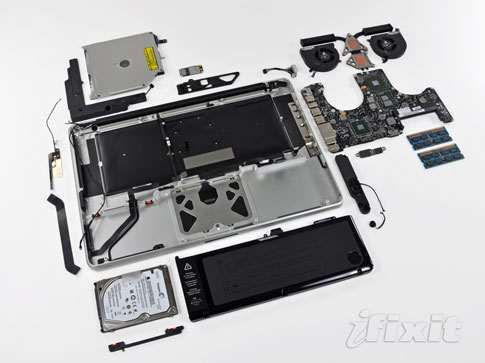iFixIt: new MacBook Pro battery 6% larger

Although it looks identical to its predecessor, Apple has made quite a few subtle tweaks to its latest professional notebook, the MacBook Pro Core i5. The crew at iFixIt tore it down to find out what Apple changed under the hood. I had suspected that Apple had increase the battery capacity, and sure enough, the new MBP packs a 6% larger 77.5 watt hour pack. See point #3 below.
Highlights:
* As usual, there's a sticker warning against removing the battery. Por qué, Apple? The printed manual that came with the machine shows you how to replace RAM and hard drive. The battery is just three screws and a connector away from being able to be replaced.
* For some odd reason, Apple has stopped using five-point Torx screws found on other MBP 15" Unibodies in favor of Tri-Wing screws. Perhaps the sound of a thousand technicians crying out in unison made them change their mind?
* The battery is now rated at 77.5 Wh. That's just a tad bit bigger (6%) than the 73 Wh battery we found in last year's 15" model, but not enough to explain the 2 hour battery life (22%) improvement Apple is claiming for this machine. Apple has dramatically reduced this machine's power consumption, and we expect it to run quite a bit cooler than the previous model.
* Apple moved the WiFi/Bluetooth board. This redesign no longer requires that the wireless connections be integrated into the camera cable, greatly decreasing the size of the connector.
* Since the WiFi/Bluetooth board is now mounted inside the all-metal case, Apple added an antenna that is mounted on the frame for the optical drive opening. Pretty clever! Time will tell what impact this move has on wireless performance.
* Apple changed the design of this speaker assembly slightly, moving from a single plastic enclosure to separate plastic enclosures for the speaker & subwoofer that are connected by the speaker leads.
* Apple announced that they are not using NVidia's Optimus technology as had been widely rumored. Instead, the OS switches to the NVIDIA GeForce GT 330M graphics as needed for higher demand applications like Chess, and uses the integrated Intel Core i5 graphics for Solitaire. (Ars Technica has a great overview of this new technology)
* Apple is using Intel's HM55 Express Chipset. Apple has clearly tweaked Intel's chipset to enable the seamless switching between the Intel and NVIDIA graphics. Interestingly enough, the chipset hub (BD82HM55) is not connected to the heat sink. Enough heat is convected from the surface of the silicon to remove the small amount of heat generated. Another advantage of this Intel chipset over Optimus is that the integrated graphics are powered down when the discrete GPU is active.
* Apple has decided that pushing battery performance is more important to consumers than pure speed, and we are seeing that philosophy integrated throughout their product line.

